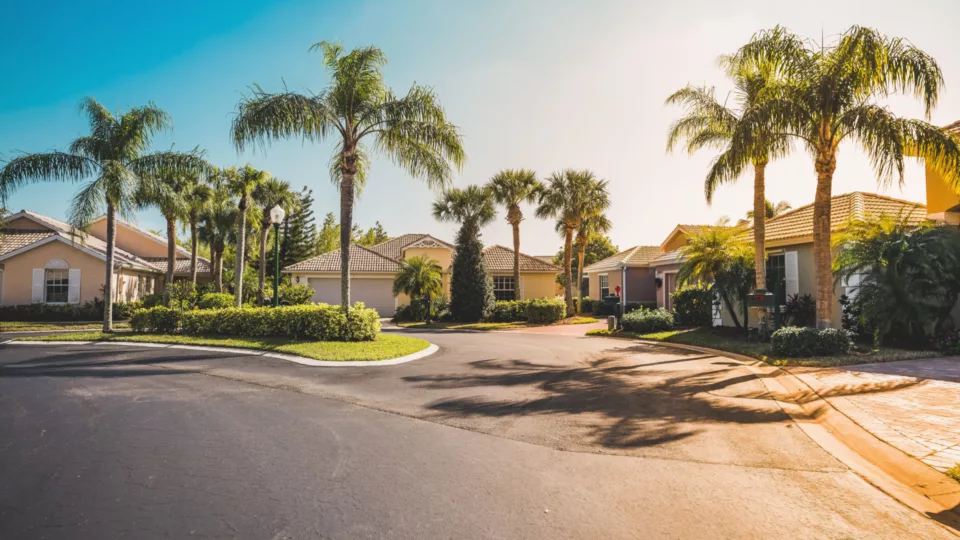In This Article
Whether it’s commercial or residential, you’re probably considering a membrane roof for your flat roof. And that’s smart, because membrane roofing systems offer low-slope roofs in Florida some of the best protection possible. But how do you choose between types of membrane roofs?
We’re Classic Roofing and Construction, and we’ve been installing and repairing flat roofs across Florida for over 20 years. That makes us your local membrane roof experts! Today, we’re going to share our advice for picking the best type of membrane roof for your home or business in Florida. But let’s start with some background: What exactly is a membrane roof, anyway?
What Are Membrane Roofs?

Membrane roofs are specially designed for flat or low-slope roofs. With sloped roofs, shingles and tiles make up most roofing systems because the water will naturally slide off the structure. But with flat roofs, water can more easily become trapped. And membrane roofs make sure that water can’t seep into your roof and cause structural issues.
Most membrane roofs have one protective layer, which makes installation fairly simple, but old built-up roofs would also qualify as roofing membranes. The membrane is typically heat-adhered to the roof, which creates a watertight seal. This ensures that your roof will not suffer water damage over the years.
CLASSIC ROOFING – FAMILY OWNED AND SERVING THE COMMUNITY FOR OVER 20 YEARS
CLASSIC ROOFING – FAMILY OWNED AND SERVING THE COMMUNITY FOR OVER 20 YEARS
The materials that make up membrane roofs can vary. But generally, the base is some kind of synthetic rubber or asphalt. Both of these materials provide resiliency, although rubber bases tend to retain their watertight seal for longer, whereas asphalt bases are better for resisting puncture damage. Differences like these are why it’s important to understand which are the best types of membrane roofs for Floridians.
So with the basics out of the way, let’s talk about your options when it comes to membrane roofs.
The Best Types of Membrane Roofs for Floridians

When it comes to finding the best membrane roofing systems, we immediately think of three roof membrane types: EPDM, TPO, and modified bitumen. Without a doubt, these are the most popular flat roofing membranes in Florida. But they each come with their own pros and cons, so let’s discuss them and help you decide which option is right for your home or business.
EPDM Roofing Membrane
Ethylene propylene diene terpolymer, or EPDM, was first created in the 1950s using synthetic rubber. This makes it completely recyclable, which makes this a great option if you want to go green with your new flat roof.
As a rubber roofing membrane, EPDM keeps all water out. And it does it for longer than any other flat roofing system with a lifespan of up to 40 years. As a bonus, EPDM membrane roofs are also very low maintenance. This means that once your EPDM is installed, it should last for a very long time without giving you any trouble. And if issues do come up, EPDM repair is usually quick and easy, so it shouldn’t run up any large bills.
But there are downsides to EPDM flat roofs as well. For one thing, it’s black, which means it will attract heat. This makes it less than ideal for homes in Florida, where year-round sun exposure can drive up your energy bills. It also doesn’t retain its shape as well as other membrane roofing systems, which can lead to shrinkage and other issues in the later phase of its life.
TPO Flat Roofing
Thermoplastic polyolefin, TPO, first hit the market in the 1990s and is sometimes seen as a replacement for EPDM. This is understandable, since both are made of synthetic rubber, but it’s more accurate to view TPO as an alternative rather than a strictly better version of EPDM.
For one thing, TPO does not last as long as EPDM. It’s still new so the average lifespan hasn’t been determined exactly, but generally, experts estimate that a TPO flat roof will last for up to 25 years. While this number is lower than the lifespan for EPDM, a TPO membrane roof has other factors in its favor.
TPO is almost always white, which helps it reflect heat away from your home. This makes it a very appealing option for Floridians, especially if cool roof status is important to you. It also has higher seam strength than EPDM, which means that it will stand up better to hurricanes and other major storms.
Modified Bitumen Roofing
Unlike the other two items on this list, mod bit is made with an asphalt base, not synthetic rubber. This makes it less flexible than TPO or EPDM, but also more resistant to puncture damage. As a result, modified bitumen is much less likely to be damaged by storm debris.
When it comes to longevity, you can expect to get about 20 years of life from your modified bitumen roof. This is only slightly less than TPO, and while 20 years is not a long time for a roof, it’s not an especially short life, either. And modified bitumen can withstand foot traffic better than any other roofing material on this list, which means it could be perfect if you expect to regularly have people walking on a commercial roof.
However, because modified bitumen doesn’t have a rubberized base, it cannot stand up to trapped water as well as other membrane roofs. But you can avert this issue with proper flat roof installation. Experienced flat roof installers will make sure that, even on a very low-slope roof, water naturally runs off. This way, you won’t have to worry about pooled water wearing away at your new modified bitumen roofing membrane.
Membrane Roof Costs and Installation
There’s still one big factor we haven’t addressed: membrane roofing cost. And that’s because it depends a lot on the specifics of your situation. Things like square footage and unique features of your roof can make your price vary widely, and so can volatile market conditions.
For that reason, we can’t tell you exactly how much your new membrane roof is going to cost without preparing a personalized estimate. But we can tell you that modified bitumen is the most affordable of these materials, followed by EPDM, and then TPO comes in as the most expensive option. Generally, however, flat roofing materials are fairly affordable, unlike metal roofing or clay tile costs.
If you’re ready to learn more about different types of roof membranes and how much a new flat roof will cost, reach out to Classic. We provide free, no-obligation roofing estimates that will cover the total costs of your flat roof replacement. With 20 years of experience and hundreds of great reviews, we’re the membrane roof experts that you want in your corner. Give us a chance to earn your business and see why Classic remains one of Florida’s top roofing companies.
Membrane Roofs – The Video
Award Winning Professionals Are Here To Help!






